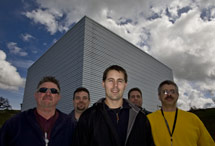
Handy Links
SLAC News Center
SLAC Today
- Subscribe
- Archives: Feb 2006-May 20, 2011
- Archives: May 23, 2011 and later
- Submit Feedback or Story Ideas
- About SLAC Today
SLAC News
Lab News
- Interactions
- Lightsources.org
- ILC NewsLine
- Int'l Science Grid This Week
- Fermilab Today
- Berkeley Lab News
- @brookhaven TODAY
- DOE Pulse
- CERN Courier
- DESY inForm
- US / LHC
SLAC Links
- Emergency
- Safety
- Policy Repository
- Site Entry Form

- Site Maps
- M & O Review
- Computing Status & Calendar
- SLAC Colloquium
- SLACspeak
- SLACspace
- SLAC Logo
- Café Menu
- Flea Market
- Web E-mail
- Marguerite Shuttle
- Discount Commuter Passes
-
Award Reporting Form
- SPIRES
- SciDoc
- Activity Groups
- Library
Stanford
Around the Bay
Where the LCLS Ends: the XPP Instrument
After journeying more than 100 meters through undulators and diagnostic equipment, X-rays from the Linac Coherent Light Source will wiggle into the subterranean Near Experimental Hall and, beginning in 2010, zip into the X-ray Pump Probe science instrument. There they will meet a sample undergoing a reaction or in an excited state and, like a camera flash in a dark room, light the sample so that researchers can photograph it in detail.
"The X-ray Pump Probe will let us look at the placement of nuclei and the structure of electrons with better time resolution than ever before," said XPP Instrument Scientist David Fritz, who is currently leading the XPP through its final stages of design. An expert in ultrafast science, Fritz joined the LCLS team two years ago after completing his PhD thesis on SLAC's Sub-Picosecond Pulse Source project. "The XPP is the most flexible instrument at LCLS, allowing us to do many of the techniques common at synchrotrons, like X-ray diffraction and small angle scattering, but with better time resolution."
Like other pump–probe instruments around the world, the XPP will use an optical laser beam as a "pump" to initiate a reaction or prepare an initial excited state in a sample. It will then use the X-ray beam as a "probe" to view how the reaction takes place or how the sample relaxes out of the excited state. By repeating this process again and again, each time changing the time delay between the optical and X-ray pulses very slightly, then stringing the series of images together, researchers can create a movie of the molecular action.
The XPP will improve upon previous such instruments with its remarkable time resolution. That's because the LCLS's X-ray beam pulses are so very thin, each with a duration of about 50 femtoseconds—equivalent to the time it takes light to travel about 15 microns. These super-quick pulses allow researchers to take crisp photos at very precise moments. By taking many such photos, they will be able to create high-quality movies with little jerkiness or blurring, revealing molecular motion and processes that might otherwise be lost.
As an example, Fritz points to a recent experiment on the myglobin molecule, a protein responsible for delivering oxygen to muscles. Using a pump–probe instrument at the European Synchrotron Radiation Facility, researchers revealed that the protein structure changed over time. Yet the technology couldn't reveal which areas changed first—it was clearly a chain-reaction, but which movements caused all the rest? The time resolution was not fine enough to tell. "We hope to be able to offer better resolution for experiments like this," Fritz said. "It's not that experiments at the LCLS will replace experiments at synchrotron sources; it's just that in some experiments, the LCLS X-ray pulses offer more information than any others."
—Kelen Tuttle
SLAC Today, March 3, 2009
